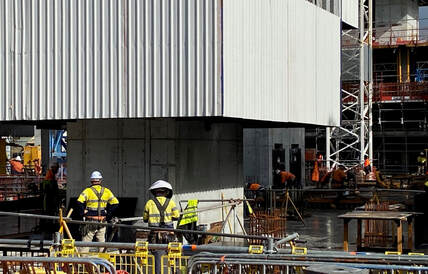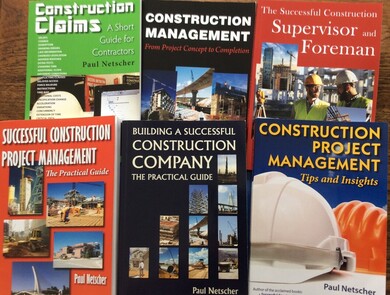"Construction project managers never seem to have enough time! Does this sound like you?" Poor time management is a problem for many of us, including the majority of Project Managers I’ve worked with. Project Managers are bombarded hourly by problems and competing demands, and if you don’t manage your time effectively it will be impossible to deal with all the issues efficiently and timeously. Top tips for construction managers to create more timeTo help things run smoothly ensure there’s an orderly filing system, and that paperwork and emails are filed in the correct place. Importantly, return documents to their correct place after you’ve finished referring to them. Searching for information is time consuming, and many tasks are left incomplete when information cannot be found. A notebook is a useful tool to assists with time management. Whilst walking around the project, talking to people, or receiving a phone call, make notes of what must be actioned. By noting all the tasks that need to be accomplished in the day, and crossing them off as they are completed, it’s possible to ensure items are not forgotten, are prioritised enabling the most urgent to be dealt with first, and that you to have a clear head, uncluttered by the mass of tasks requiring attention. "Time is valuable - learn to protect your time." It’s also important to protect your time. A Project Manager always has multiple issues to deal with, people in and out of the office, and the telephone ringing. Somehow your time must be divided up to attend to everyone’s demands while actioning important tasks. Sometimes when the issue or call is relatively minor you may have to be rude (in a nice way of course), and ask a person to contact you again later. Consideration may even be given to working after-hours when the chance of interruption is less. Alternatively, set aside a regular hour every day to attend to specific tasks, and let staff know you don’t want to be interrupted during this period, other than for an emergency. Of course effective delegation is essential to proper time management. Often Project Managers micro-manage their employees, spending time supervising and organising tasks which your team are more than capable of doing. In other cases Project Managers take on too many tasks, failing to delegate some of these to the team. This is often because you don’t trust your team, or in some cases don’t want to take the time to explain how to do the task. Poor planning often results in wasted time. Poor planning causes Project Managers to be interrupted to resolve problems that proper planning would have prevented, and solving these problems takes additional time. Create more time to do things you enjoyConstruction managers must learn to manage their time more effectively. Don't let poor time management mean that you miss things on the project, or that you work long hours. Sure, sometimes you need to stay late occasionally on the project, but this should never be a regular occurence. Ensure that you plan, delegate, and protect your time. You will be a more effective project manager. Other articles by the author: Planning your construction project Will your construction project be completed on schedule © 2015 This article is not to be reproduced for commercial purposes without written permission from the author. Do you want to learn how to manage construction projects successfullyPaul Netscher has written several easy to read books for owners, contractors, construction managers, construction supervisors and foremen. They cover all aspects of construction management and are filled with tips and insights.
Visit to read more. The books are available in paper and ebook from most online stores including Amazon.
5 Comments
"One of the most important aspects of managing a construction project is to be able to manage, work with, and interact with people." As a child we played a game which I’m sure many of you played. We sat in a circle and one person whispered a message in to their neighbour’s ear who then passed the message to their neighbour by whispering in their ear, who passed the message on, and so it went around the circle to eventually reach the person who started the message. Invariably the final message was vastly different to the original. This childhood game clearly demonstrates how messages get misinterpreted. This is even more so in construction where communication is key to a successful project. Imagine on a project if the client said to the architect; “build me a house”, who interpreted it as; “build me a palace”, Then told the contractor what to build and they built; “a warehouse”. We laugh, but this is sometimes almost what happens. #constructionmanagement #constructioncommunication Diversity in constructionOne of the most important aspects of managing a construction project is to be able to manage, work with, and interact with people. Construction projects involve a number of different parties, such as the client, managing contractor, subcontractors, members of the public, Design Engineers, Architects, managers within the company, project staff, tradespeople, general workers, suppliers and their representatives, local businesses and building inspectors. Many of these people come from diverse countries, cultures, languages, socio economic backgrounds, and educational backgrounds. In construction we may have to deal with an irate member of the public who is say upset that our delivery truck drove in front of them, discuss a design problem with the Designer, deal with the client’s banker, or talk to a construction worker in a third world country who may never have had a formal job before (let alone, construction experience). All of these people have to be treated in an equal manner "Construction managers have to use all our people skills to negotiate, persuade, and lead the people working on the project" No matter how frustrated we are, or how bad the day has been, there is simply no place on a construction site where you can hide from dealing with people and their problems. We have to use all our people skills to negotiate, persuade, and lead the people working on the project, while at all times remaining calm. We have to establish and maintain relations with the client, the design team and our team. In all of this we also have to be a coach, a teacher and a mentor to their team. Understanding the diversity of people in construction and being sensitive to cultural differences can be useful when negotiating, since different techniques can be used depending on the person’s background. One technique may yield little or no success with one individual, while another technique will work. Understanding the cultures and backgrounds of the people working on a project will enable better relationships and teams to be formed. "Communication is something that we have to do on construction all the time" Good communication is essential in constructionCommunication is something that we have to do on construction all the time, every day. It’s both verbal and written. Communication should:
Keeping all project stakeholders informedBut communication isn’t just about giving and receiving instructions, it’s also about keeping the various stake holders informed about developments on the project, irrespective of whether they are project staff, workers, subcontractors, suppliers, client representatives, the client or neighbours. The amount and level of communication will vary according to circumstances and the individual. Communication is often best given verbally, which could be at meetings, directly one-on-one, or via telephone. However it may sometimes be in the form of letters or memos that may be addressed to specific individuals, or may be just generalised memos handed to all affected parties, or displayed on project notice boards. "Often things are said, or written in haste, which are regretted long after the event." When issuing letters, emails, memos and verbal communications thought must go into the type of communication. Inappropriate communications can cause irreparable harm to the project, individuals and personal reputations. Often things are said, or written in haste, which are regretted long after the event. "Sometimes a conversation with the client over a cup of coffee can yield far better results than a formal letter." Sometimes a conversation with the client over a cup of coffee can yield far better results than a formal letter. Communication is a two-way streetPart of successful communication is also to listen, to make sure you understand what the other person is saying and ask questions when unsure. Sometimes it's also about what the person isn't saying. Again, people from different cultural backgrounds may say things which we misunderstand or misinterpret because we don't understand them properly. Following the right channelsOn large projects, communications may be addressed to the client, the client’s representative, subcontractors or suppliers, and these may be issued by various staff members. It’s always important the correct channels of communications are used, and only authorised staff members communicate with the relevant parties. If more than one member of staff communicates with any of the parties it can cause confusion, and result in the other party receiving mixed and confusing communications, which is not only unprofessional but can lead to problems. "Communication should be directed to the correct person." Communication should be directed to the correct person. Often communication is addressed to a person who isn't authorised to receive communication, or communication by-passes their manager. This may mean that the communication isn't acted on. All staff must be aware of the communication protocol, and all correspondence should be carried out in a professional manner. All correspondence of a contractual or financial nature should be reviewed by the Project Manager. Written construction communication"Sometimes verbal discussions should be formalised by a letter afterwards." Having said the above it is important that some communication is formalised, particularly communication of a contractual nature. Verbal and hand-shake communications are open to misinterpretation and even to being forgotten completely. It’s also useful to keep formal minutes of meetings which ensure that all attendees are reminded of what was agreed and what needs to be actioned. Sometimes verbal discussions should be formalised by a letter afterwards. That formal letter to the client may be better received after that chat over coffee. Good communication can avoid many problems in constructionMany of the problems on construction projects can be avoided if we communicated better. (Written by Paul Netscher the author of the acclaimed books ‘Successful Construction Project Management: The Practical Guide’ and ‘Building a Successful Construction Company: The Practical Guide’. Both books are available in paperback and e-book from Amazon and other retail outlets. This article is adapted from information included in these books. ) Paul Netscher has written several easy to read books for owners, contractors, construction managers, construction supervisors and foremen. They cover all aspects of construction management and are filled with tips and insights. Visit to read more. The books are available in paper and ebook from most online stores including Amazon. © 2022 This article is not to be reproduced for commercial purposes without written permission from the author.
You’ve submitted your price for the construction project, been through a tough negotiation and finally you are told the project is yours to construct. Jubilation and joy! Let’s get started. Construction project bid negotiations – Don’t make a mistake Unfortunately this is where some contractors get into trouble. Do not start a construction project until there is a contract in placeWithout a contract there’s no agreement, no protection for the contractor and no guarantee that the contractor will be paid for the work they do. Therefore ensure that there is a signed agreement in place before starting a construction project. Furthermore, failure to agree the contract terms and conditions prior to starting construction work means that when the contractor finally reviews them they have often incurred costs on the project and aren’t in a position to persuade the client to alter the terms and conditions to those that are more appropriate or acceptable. #constructioncontracts #constructionlaw #constructionmanagement Does a letter of intent protect us"letters of intent do not always offer the contractor protection" Sometimes the client hasn’t completed preparing the contract documents but is in a hurry to get the contractor to start construction. In this case they may issue a letter of intent, or similar document. These documents are often only a couple of lines long and offer the contractor little protection if things go wrong. If a contractor has to work with a letter of intent then the letter should: 1. be signed by an authorised representative of the client 2. be signed and acknowledged by the contractor 3. be dated 4. have the correct names of the contracting parties 5. refer to the tender conditions 6. refer to the contractor’s tender submission 7. refer to a scope of work 8. have the payment terms and conditions 9. include a termination clause 10. refer to a contract schedule or milestone dates 11. include a date by which the contract document will be issued to the contractor Some Letters of Intent have a set value or are only valid for a specific time period, so it’s important to ensure these values or dates aren’t exceeded since the contractor may find that they aren’t paid for work carried out in excess of that specified Checking the contract documentHave you checked the contract document? At last the contract document arrives. But does it contain the same conditions you priced? Unfortunately some contractors are only too eager to get the project started so sign the document without carefully checking it. "Check that the conditions in the contract are the same as the conditions you priced" Before signing the contract ensure that: 1. the document is the same as the tender document including checking that: a. no clauses have been altered (unless these alterations have been agreed) b. the drawings included, or referenced, are the same as those in the tender including the same revision number c. no new drawings have been added d. the specifications are the same 2. the price is as per the tender and includes all post-tender variations 3. the exclusions in the tender submission which have been accepted are included 4. the schedule is in accordance with the agreed dates I’ve often received documents that had different conditions to those agreed. Even minor alterations to clause wording can drastically alter the meaning and intent. Failure to detect these alterations could result in the contractor committing to undertake work that they’ve not priced or to conditions they haven’t allowed for. In addition the contract document is often signed weeks or even months after work started so it’s important that the document takes cognisance of all delays or variations that occurred up to the date of signing. Ensuring your company is protected before starting constructionContractors shouldn’t allow themselves to be rushed into starting a project without ensuring that their contractual rights are protected. This may mean that you upset your client, or even that they remove the contract from you. But failing to ensure that you are committed to build a project under the agreed conditions you priced could prove to be very expensive. Don’t Start Your Next Construction Project Before Reading This Other similar articles by the author Your tender submission or quotation – get it right How you can make your next construction project more successful What makes a good client For more go to: Index of construction articles  (Written by Paul Netscher the author of the acclaimed books ‘Successful Construction Project Management: The Practical Guide’ and ‘Building a Successful Construction Company: The Practical Guide’. Both books are available in paperback and e-book from Amazon and other retail outlets. This article is adapted from information included in these books.) © 2022 This article is not to be reproduced for commercial purposes without written permission from the author.
Over the last 2 weeks I posted 2 articles: ‘Are your subcontractors profitable? Should you care?’ and: ‘Managing your subcontractors. Ensure your project is successful.’ Thank you to the many people who read and commented on the article. Most comments mentioned poor communication and the poor selection of subcontractors as leading causes of problems with subcontractors. In this article I ask the question: ‘Do your subcontractors really understand what is expected of them?’ Many readers will say; ‘of course yes, it’s spelled out in our document.’ My answer; ‘are you sure?’ Case Study: Several months ago the neighbours across the street engaged a contractor to do renovations on their house. One Saturday at 6.45am the neighbourhood was awoken by loud bashing and noise at the house. Fortunately I was up and opening our upstairs windows and saw a plastering subcontractor off-loading their truck and setting up the work area. I shouted a comment to the affect that they shouldn’t be making a noise so early in the morning, especially not on the weekend, to which the contractor replied I was welcome to complain to the council. 10 minutes later I was working in my front garden and got a torrent of abuse, with liberal swearing, from the subcontractor. I said nothing and walked across to see the owners of the house. While I was ringing the door-bell I received further verbal abuse which only stopped when another neighbour walked past and enquired what the problem was. The subcontractor then said he couldn’t work under these conditions, threw everything back on his truck and drove off with screeching tyres leaving the work unfinished. Needless to say when I complained to the owners of the house they weren't very impressed with their contractor because their neighbours had been disturbed by the noise and verbally abused. Well I can’t remember the name of the subcontractor but I do remember the name of the main contractor – after all their sign board stood outside the property for 3 months. Would I use that main contractor or recommend them to anyone – definitely not. Did I tell others about my experience – of course I did. "What harm are your subcontractors doing to your company’s good name?" So back to my question: ‘Do your subcontractors understand what is expected of them?’ What harm are your subcontractors doing to your company’s good name? Communication starts when the subcontractor is issued information to price the works. This documentation needs to be clear so the subcontractor knows what’s expected of them. This documentation forms part of the contract document which is used to administer the contract. Once work starts there are further communications and meetings. At every stage there are opportunities for misunderstandings or for information to be left out. Subcontractor pricing documentationSubcontract pricing information and documentation will vary depending on the type and size of the subcontract works. But no matter the project size the information and documentation should be as clear and complete as possible, so there is no cause for misunderstandings which could result in quality, schedule and safety problems, or lead to claims and variations while executing the construction project works. The pricing documentation should provide sufficient information for the subcontractor to price their portion of the construction project and provide details of the contractor's expectations of the subcontractor and the construction project conditions. What to include in Subcontractor pricing documentation Subcontractor contract documentation"Subcontract documentation does not have to be lengthy" The subcontract contract document is a legally binding contract between the subcontractor and contractor with enforceable provisions on both parties. If this document is poorly worded, inconsistent or incomplete, it can lead to complications with the management of the subcontractor resulting in the contractor incurring additional expenses, delays, even quality and safety problems on the project, and in the worst case, protracted legal arguments. Much of the contract documentation should have formed part of the documentation provided to the subcontractor when they priced the work. It should be noted that this document usually doesn’t have to be hundreds of pages long as someone has recently mentioned they had to sign. In fact longer contract documents can lead to more confusion, ambiguities and contradictions. Subcontractor construction contract documents and Subcontractor contract documents part 2 Project communication with subcontractors"Communication of a contractual nature, including those involving time and cost, must be in writing" Communication with the subcontractor regarding variations (changes and additions), instructions, additional information, schedule changes and approvals, quality, safety and progress concerns, and all contractual matters should be addressed in writing to the subcontractor’s authorised representative, and should emanate only from the contractor’s designated representative. Any verbal discussions, regarding the above matters, should be followed up in writing to ensure there are no misunderstandings, there is a record of what was said, and that the appropriate people are aware of what was discussed. Copies of all instructions and contractual information should be distributed to the Project Manager, as well as the contractor’s contract administration staff. "Communication must be directed to the subcontractor's designated responsible person" Of course it’s important communication is directed to delegated subcontractor’s representative, otherwise it may become lost or be ignored. Subcontractors have their own hierarchy and it pays for contractors to respect this and not direct instructions to the subcontractor’s workers. Equally important is that the subcontractor isn’t bombarded by communication coming from different members of the contractor’s team which could cause confusion. Subcontractor meetingsIt’s useful to have a preconstruction or kick-off meeting to ensure that all parties understand the construction project ground rules. Regular progress meetings should also be held with the subcontractor during the course of construction. I will discuss meetings in another article. Construction project inductionsSubcontractors’ personnel should attend the main contractor's (general contractor) project induction. Unfortunately many of these inductions are poorly presented. However, a good induction is an opportunity to explain to all workers what’s expected of them on the project in terms of safety, quality and behaviour as well as explaining how the team fits together and particular concerns and risks on the project. Site or project inductions "are your subcontractors aligned with your company’s values" Subcontractor values But there’s more! But despite all of the documentation, meetings and communications does the subcontractor really understand what’s expected from them? This means are they aligned with your company’s values? Do they understand your company’s safety and quality expectations? Will they respect your work and other contractor’s work? Do they treat their employees fairly? Will their actions uphold your company’s good name with your clients, neighbours and members of the public? How do you communicate this to the subcontractor? The starting point is by engaging subcontractors who share the same values as your company. It helps if the contract documentation is unambiguous and clear. After this subcontractors need to be managed, clearly directed and assisted when needed. Selecting subcontractors for your construction project Subcontractors are often vital to a successful construction project"A poor subcontractor can derail a project and tarnish a contractor’s good name." Subcontractors are integral to the success of most projects. A poor subcontractor can derail a project and tarnish a contractor’s good name. Good communication is essential in ensuring your subcontractors don’t let your project and company down. #subcontractors #constructionmanagement #constructionprojectmanagement Other articles by the author Why construction companies should be concerned about their reputation Understanding what impacts your construction company’s reputation Avoiding disputes on your construction project Paul Netscher has written several easy to read books for owners, contractors, construction managers, construction supervisors and foremen. They cover all aspects of construction management and are filled with tips and insights. Visit to read more. The books are available in paper and ebook from most online stores including Amazon. © 2022 This article is not to be reproduced for commercial purposes without written permission from the author.
 Picture courtesy of A Current Affair, Channel 9 Picture courtesy of A Current Affair, Channel 9 Construction companies are facing increasing pricing pressures. In an attempt to bring their costs down they are shopping for materials around the world. But do these materials comply with local standards? Are they reliable? Are they safe to use? What hidden dangers do they pose to future occupants of the facility? Unfortunately owners are often also complicit in this problem, selecting, specifying or approving the use of products that aren’t compliant just to reduce the cost of their building so they can make more profit. Alarmingly there are reports that many new buildings in Australia have used an external cladding that is highly flammable. View these 2 reports that show frightening images of how rapidly a fire spread up the outside of a high-rise apartment block http://www.abc.net.au/7.30/content/2015/s4243787.htm http://aca.ninemsn.com.au/article/9015280/unit-fires Procuring new and innovative materials present many new opportunities and possible reduced costs. However, they do pose challenges. What you need to consider when procuring materials When materials are procured from a foreign supplier it’s important to ensure: 1. the items will comply with the project’s standards and specifications (other countries use different standards) 2. the items are approved for use in the country where the facility is located 3. the items are safe to use 4. the tradespeople installing the product have the required skills and training required to install the product 5. the items are compatible with local products 6. spare parts will be readily available 7. warranties and guarantees will be valid 8. there are no additional costs for the importation of the items, such as additional taxes and import duties 9. the transport costs are factored into the overall cost 10. the product has lifetime and maintenance expectations similar to the comparable local product 11. the product is being installed in locations it’s designed for, and faces conditions similar to the ones where it has been tested Even when procuring from local suppliers ensure that the products do comply with the local specifications. Conclusion Replacing a product that does not comply with the local specifications or conditions could be very costly for contractors and owners. It may result in the facility being shut-down. But worse still, consider the potential dangers such as posed by the fire risk in the attached articles. Would you want to be responsible for the death of occupants of a facility you built because you tried to save a few dollars and used a non-compliant product? Other similar articles by the author: Is the cheapest really the cheapest? Increase profits – reduce material wastage on construction projects Construction guarantees and warrantees (Written by Paul Netscher the author of the acclaimed books ‘Successful Construction Project Management: The Practical Guide’ and ‘Building a Successful Construction Company: The Practical Guide’. Both books are available in paperback and e-book from Amazon and other retail outlets.) © 2015 This article is not to be reproduced for commercial purposes without written permission from the author. |
Archives
June 2024
Note: We welcome genuine comments, especially comments that add additional information to the subject matter in the article. We however reserve the right to remove inappropriate comments, which includes comments that have nothing to do with the subject, comments that include inappropriate language, and comments that are an advertisement for a product or company, or which include an advertising link. Comments must be in English. We will not enter into discussion on why a particular comment was removed.
CategoriesCopyright 2016 - The attached articles cannot be reproduced for commercial purposes without the consent of the author.
The opinions expressed in the attached articles are those of the writer. It should be noted that projects are varied and different laws and restrictions apply which depend on the location of the contractor and the project. It's important that the reader uses the supplied information taking cognisance of their particular circumstances. The writer assumes no responsibility or liability for any loss of any kind arising from the reader using the information or advice contained herein. "I have what I consider some of the best books on construction management."
Books are available from: Amazon.com Amazon.co.uk takealot.com kalahari.com Amazon.in Amazon.de Amazon.fr Amazon.it Amazon.com.au Powell's Fishpond uread bokus Amazon.ca Amazon.es Other retail stores Available in paperback or on Kindle "28 YEARS OF CONSTRUCTION PROJECT MANAGEMENT EXPERIENCE, DEVELOPING SUCCESSFUL CONSTRUCTION PROJECT MANAGERS AND BUILDING SUCCESSFUL CONSTRUCTION COMPANIES"
|



















 RSS Feed
RSS Feed




